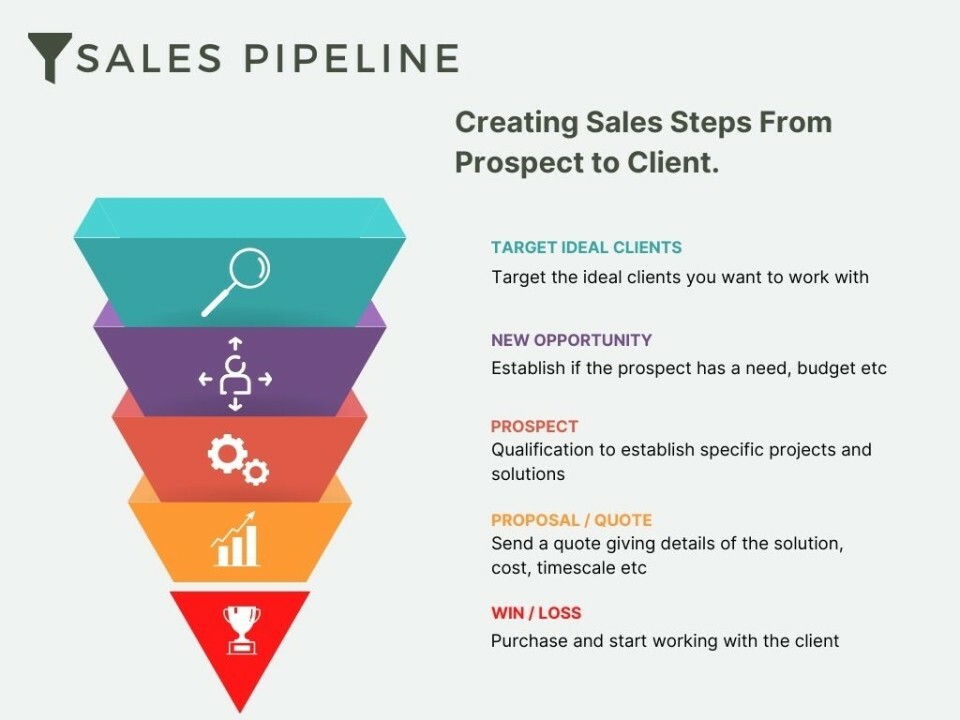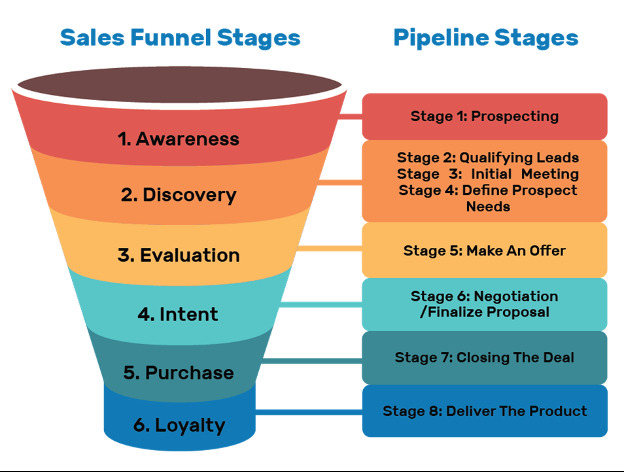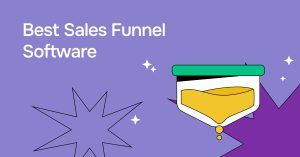Existing customer? Sign in
How to Build a Sales Pipeline from Scratch: A Comprehensive Guide

How to build a sales pipeline from scratch: Building a strong sales pipeline is crucial when running a successful business. A sales pipeline visually represents your sales process, from lead generation to closing deals. It helps you keep track of your potential customers and the progress of each sale, enabling you to make informed decisions and optimize your sales efforts.
But how do you build a sales pipeline from scratch, especially if you’re new to sales or starting a new business? In this comprehensive guide, we will walk you through the process step by step, sharing valuable tips and strategies to help you successfully build and manage a sales pipeline.
Whether you’re a seasoned sales professional looking to fine-tune your approach, or a business owner just starting, this guide will provide you with the knowledge and tools you need to build a sales pipeline that will drive growth and success. So let’s dive in and learn how to build a sales pipeline from scratch!
Click here and Learn more
How to build a sales pipeline from scratch – Understanding the Basics: Key Components of a Sales Pipeline
In the world of sales, having a well-defined and organized sales pipeline is crucial to success. A sales pipeline refers to the various stages that a potential customer goes through before making a purchase. Understanding the key components of a sales pipeline is essential for any business looking to build and grow their sales strategy. How do you build a sales pipeline from scratch? Let’s dive into the basics.
The first component of a sales pipeline is prospecting. This involves identifying and reaching out to potential customers who may be interested in your product or service. Prospecting can be done through various channels, such as cold calling, email marketing, or social media outreach. The goal here is to gather a substantial pool of leads to move forward with.
Once you have a list of potential customers, the next step is to qualify them. This involves determining if they have a need for your product or service if they have the budget to make a purchase, and if they have the authority to make buying decisions. Qualifying leads helps you focus your efforts on those who are most likely to convert into paying customers.
After qualifying leads, the next component is the proposal stage. This is where you present your product or service to the potential customer and showcase its value. A well-crafted proposal addresses the specific needs and pain points of the customer, offering a tailored solution. It’s important to keep communication open during this stage and address any concerns or questions the customer may have.
The final stage of a sales pipeline is closing the deal. This is when the customer officially makes a purchase and becomes a paying customer. It’s important to have a smooth and efficient process for closing deals, such as having clear contract terms and a simple payment system. Additionally, following up with customers after the sale can help foster long-term relationships and potential future sales.
Building a sales pipeline from scratch takes time and effort, but it’s a crucial aspect of any successful sales strategy. By understanding the key components and following a systematic approach, businesses can effectively generate leads, qualify them, present a compelling proposal, and ultimately close deals. Remember, a well-structured sales pipeline is the backbone of a thriving sales process, leading to increased revenue and business growth.
Click here and Learn more
How to build a sales pipeline from scratch – Setting the Foundation: Defining Your Sales Goals and Target Audience

If you’re a business owner or a sales professional, you know that building a strong sales pipeline is essential for sustainable growth and success. But where do you start? How do you build a sales pipeline from scratch? Well, it all begins with setting the foundation, which involves defining your sales goals and identifying your target audience.
First and foremost, clearly define your sales goals. Ask yourself what you want to achieve with your sales efforts. Are you looking to increase revenue? Expand your customer base? Launch a new product or service? Setting specific, measurable, achievable, relevant, and time-bound (SMART) goals will provide you with a clear roadmap for building your sales pipeline.
Next, identify your target audience. Who are your ideal customers? What are their needs, pain points, and desires? Conduct market research, analyze customer demographics, and leverage data to develop a comprehensive understanding of your target audience. This will enable you to tailor your sales strategies and messaging to resonate with your ideal customers.
Once you have established your sales goals and identified your target audience, it’s time to start building your sales pipeline. But remember, building a sales pipeline is an ongoing process that requires consistent effort and refinement. Stay proactive, continuously evaluate and adjust your strategies as needed, and leverage the right tools and technologies to streamline your sales process.
In conclusion, building a sales pipeline from scratch requires a strong foundation. By clearly defining your sales goals and identifying your target audience, you’ll be able to develop effective strategies and tactics to drive sales and achieve your business objectives. Remember, Rome wasn’t built in a day, and neither is a successful sales pipeline. Stay focused, stay persistent, and you’ll be well on your way to building a robust sales pipeline that fuels your business growth.
Crafting a Winning Sales Strategy: Steps to Prospect and Qualify Leads
Building a successful sales strategy requires careful planning and execution. One crucial step in this process is prospecting and qualifying leads. Without a strong pipeline of potential clients, the chances of closing deals and achieving sales targets diminish significantly. To ensure your sales team has a steady stream of qualified leads, here are some steps to follow.
The first step in prospecting is defining your target market. Understanding your ideal customer profile allows you to focus your efforts on prospects that are most likely to convert into customers. Conducting market research, analyzing customer data, and identifying key demographics will help you narrow down your target audience. This clarity will guide your sales team in reaching out to the right prospects and customizing their sales approach.
Next, it’s important to build a sales pipeline from scratch. Start by generating leads through various channels like social media, website forms, or networking events. Implementing lead-generation strategies like content marketing or email campaigns can help capture the attention of potential customers. Once you have leads, it’s crucial to qualify them by assessing their fit with your product or service. This involves evaluating factors such as their level of interest, budget, timeline, and decision-making authority.
As you prospect and qualify leads, it’s important to have a system in place to track and manage your sales pipeline. Utilize customer relationship management (CRM) software to keep all relevant information organized. This allows you to prioritize prospects, follow up effectively, and measure your sales team’s progress. Regularly review and update your sales pipeline to ensure a healthy flow of leads and adjust your strategy as needed.
Crafting a winning sales strategy requires a calculated approach to prospecting and qualifying leads. By clearly defining your target market, building a sales pipeline from scratch, and effectively managing it, you set your sales team up for success. Remember, a strong pipeline of qualified leads provides the foundation for achieving your sales goals and driving business growth.
Tools of the Trade: Utilizing CRM Software for Sales Pipeline Management
In the world of sales, having an efficient and organized sales pipeline is crucial for success. It allows you to track and manage your leads, prioritize your efforts, and ultimately close more deals. While building a sales pipeline from scratch may sound like a daunting task, with the right tools at your disposal, it becomes a simpler and more effective process.
One such tool that can greatly enhance your sales pipeline management is CRM software. Customer Relationship Management (CRM) software provides a centralized platform to store and organize all your customer data, including leads, contacts, and opportunities. It enables you to track the progress of each lead and move them through different stages of the sales process smoothly.
With CRM software, you can easily capture and import leads, assign them to sales representatives, and automatically track their activities. This saves you time and effort and ensures that no potential opportunity falls through the cracks. Moreover, CRM software allows you to analyze and measure key performance metrics, such as conversion rates and deal sizes, providing valuable insights to optimize your sales strategy.
To build a sales pipeline from scratch using CRM software, it’s essential to first define your target audience and create buyer personas. Identify the characteristics of your ideal customers and tailor your sales efforts accordingly. Then, import your existing contacts and start segmenting them based on their buying preferences, demographics, or any other relevant criteria.
Next, use the CRM software to track and manage your leads. Assign them to specific sales representatives and define different stages in the sales process. Make sure to update the status of each lead as it progresses through the pipeline, allowing for accurate forecasting and resource allocation.
In conclusion, utilizing CRM software for sales pipeline management is a game-changer for any sales team. It streamlines your processes, improves efficiency, and ultimately boosts your sales performance. By following the right steps and using the features offered by CRM software, you can build a sales pipeline from scratch with ease and take your business to new heights.
Nurturing Leads: Strategies for Effective Lead Follow-Up and Engagement
In today’s competitive business landscape, building a strong sales pipeline is crucial for success. And the first step in building that pipeline is nurturing leads and effectively following up with potential customers. Lead follow-up and engagement play a vital role in converting prospects into loyal customers.
To effectively nurture leads, it is important to understand their needs and preferences. Utilize customer relationship management (CRM) tools to gather relevant data and develop a comprehensive understanding of your leads. This will enable you to personalize your approach and provide tailored solutions to their problems.
One effective strategy for lead follow-up is timely response. Promptly respond to inquiries and requests, whether it’s through email, phone calls, or social media channels. This shows your commitment and helps build credibility. Additionally, automate follow-up processes using email marketing tools to regularly engage with leads, share valuable content, and keep them updated about new offerings.
Another key aspect of lead nurturing is building relationships. Establish yourself as a reliable and trustworthy resource by providing valuable insights and information. Share industry knowledge, case studies, and success stories to establish credibility and position yourself as an expert in your field. Remember, effective lead nurture is not about pushing sales, but about building trust and long-term relationships.
Finally, track and measure your lead nurturing efforts to continuously improve and optimize your strategies. Analyze data to identify bottlenecks in the sales pipeline and make necessary adjustments. Regularly monitor open rates, click-through rates, and conversion rates to gauge the effectiveness of your engagement efforts.
In conclusion, nurturing leads is essential for building a successful sales pipeline. By understanding your leads, responding promptly, building relationships, and continuously optimizing your strategies, you can effectively engage prospects and convert them into loyal customers. So, follow these strategies to build a sales pipeline from scratch and watch your business flourish.
Closing the Deal: Techniques for Conversion and Sales Success
Closing the Deal: Techniques for Conversion and Sales Success
In the world of sales, closing the deal is the ultimate goal. It’s the moment when all your hard work and effort come to fruition, and the customer commits to making a purchase. However achieving this level of success requires more than just charm and persuasive skills. It takes a well-defined strategy and the ability to build a strong sales pipeline from scratch.
So, how exactly do you build a sales pipeline from scratch? The first step is to identify your target market and understand their needs and pain points. This will allow you to tailor your messaging and approach to resonate with them. Next, you’ll need to create awareness and generate leads through various marketing channels such as social media, content marketing, and email campaigns.
Once you have a pool of potential customers, it’s time to nurture those leads and build relationships. This involves engaging with them through regular communication, providing valuable content and resources, and addressing any objections or concerns they may have. By doing so, you can move these leads through the different stages of the sales pipeline, from awareness to consideration and eventually, to the decision-making stage.
Closing the deal requires a combination of skills and techniques. A key aspect is understanding the buyer’s journey and adapting your sales approach accordingly. This means being able to identify where the buyer is in their decision-making process and providing the right information and support at each stage. Additionally, effective negotiation skills and the ability to address objections are crucial for sealing the deal.
Overall, closing the deal is the ultimate goal for any salesperson or business. By following these techniques and building a strong sales pipeline from scratch, you can increase your chances of conversion and sales success. Remember to always prioritize your customers’ needs, build relationships, and adapt your approach to meet their specific requirements. With dedication and persistence, you’ll be well on your way to closing those deals and achieving your sales targets.
Tracking Success: Using Metrics and KPIs to Measure Sales Pipeline Performance
Building a successful sales pipeline is essential for any business looking to drive growth and increase revenue. But how do you measure the effectiveness of your pipeline? That’s where metrics and key performance indicators (KPIs) come in. These quantifiable measurements allow you to track and analyze the performance of your sales pipeline, giving you valuable insights into what’s working and what needs improvement.
To build a sales pipeline from scratch, you first need to identify your target audience and create a database of potential leads. From there, you can start tracking metrics such as the number of leads generated, the conversion rate from leads to opportunities, and the average deal size. These metrics will help you understand the overall health of your pipeline and identify areas where you may need to make adjustments.
In addition to these KPIs, it’s crucial to monitor the velocity at which leads move through your pipeline. This metric measures the length of time it takes for a lead to progress from one stage to another. By analyzing your pipeline velocity, you can identify bottlenecks or areas where leads are getting stuck, allowing you to take action to improve the flow and increase conversion rates.
Ultimately, tracking metrics and KPIs provides you with a data-driven approach to measuring the success of your sales pipeline. By regularly monitoring these measurements and making adjustments as necessary, you can continually optimize your pipeline and drive better sales results for your business. So, don’t underestimate the power of metrics and KPIs when it comes to tracking the performance of your sales pipeline.
Optimizing Your Pipeline: Continuously Refining and Improving Your Sales Process
When it comes to running a successful sales operation, having an optimized pipeline is crucial. A well-designed and efficient sales process can lead to increased conversions, higher revenue, and improved customer satisfaction. However, building a sales pipeline from scratch can be a daunting task for many businesses.
To start, you need to clearly define your target audience and create buyer personas that represent your ideal customers. This will help you tailor your sales approach and messaging to effectively reach and engage with your prospects. Once you’ve identified your target audience, it’s time to gather leads and build a database of potential customers. Leverage various channels such as social media, email campaigns, and content marketing to attract and capture leads.
Next, it’s important to segment and prioritize your leads based on their level of interest and potential to convert. This will ensure that your sales team is focused on the most promising prospects, maximizing their efficiency and productivity. Implementing lead scoring mechanisms and using customer relationship management (CRM) software can greatly assist in this process.
Continuous refinement and improvement are also key to optimizing your sales pipeline. Regularly reviewing and analyzing your sales data will provide valuable insights into which stages of the process may need adjustment or enhancement. Monitor key performance indicators (KPIs) such as conversion rates, average deal values, and sales cycle length to identify areas for improvement. Utilize feedback from your sales team and customers to fine-tune your sales process and make it more effective in driving results.
Building a sales pipeline from scratch may seem challenging, but with the right strategies and tools, it can be a rewarding and profitable endeavor. By understanding your target audience, capturing leads, segmenting and prioritizing prospects, and continuously refining your approach, you can create a sales process that consistently delivers results. Remember, optimization is an ongoing process, so be sure to monitor your pipeline regularly and adapt as necessary to stay ahead of the competition and meet your sales goals.
Implementing Automation: Leveraging Technology for Streamlined Sales Operations
In today’s fast-paced business landscape, implementing automation is no longer a luxury but a necessity. Sales operations play a vital role in any organization, and leveraging technology can streamline the entire process. One significant aspect of sales operations is building a sales pipeline from scratch – the path that leads a potential customer from awareness to making a purchase.
So, how can technology assist in this process? Firstly, automation tools can collect and analyze data, enabling businesses to identify and target potential customers more effectively. By utilizing customer relationship management (CRM) software, companies can track and manage customer interactions, ensuring that no leads fall through the cracks. Automation can also be leveraged to nurture leads by sending personalized and timely follow-up emails, increasing the chances of conversion.
Another way technology can streamline sales operations is through the use of artificial intelligence (AI). AI-powered chatbots can engage with potential customers in real time, providing instant support and answering their queries promptly. This not only saves time for the sales team but also ensures that customers receive the assistance they need, fostering a positive experience. Additionally, AI algorithms can analyze customer behavior and preferences, allowing businesses to personalize their sales approach and offer tailored solutions.
Furthermore, automation can improve internal communication within the sales team. Collaboration tools and project management software ensure that all team members have access to the latest information, minimizing miscommunication and effectively coordinating tasks. These tools also provide valuable insights into team productivity, allowing managers to identify areas for improvement and optimize the overall sales process.
In conclusion, implementing automation is key to streamlining sales operations. From collecting and analyzing data to leveraging AI-powered solutions, technology plays a crucial role in building a sales pipeline from scratch. By embracing automation tools, organizations can capitalize on their efficiency, improve customer experiences, and achieve better sales results.
Pitfalls to Avoid: Common Mistakes When Building a Sales Pipeline and How to Overcome Them
Building a sales pipeline is crucial for any business looking to drive revenue and achieve growth. However, it can be a complex process that requires careful planning and execution. Unfortunately, many companies make common mistakes that hinder the success of their pipeline. In this article, we will explore some of these pitfalls and provide insights on how to overcome them.
One common mistake is neglecting to properly define your ideal customer profile (ICP). Without a clear understanding of your target audience, it becomes difficult to effectively nurture leads and close deals. Therefore, take the time to analyze your existing customer base and identify key characteristics that make up your ICP. Develop buyer personas that encompass these attributes and tailor your messaging and outreach efforts accordingly.
Another pitfall to watch out for is the failure to implement a structured lead qualification process. It can be tempting to chase every potential lead that comes your way, but this approach can be detrimental to your pipeline. Instead, establish clear criteria for lead qualification based on factors such as budget, authority, need, and timeline (BANT). This will help you prioritize leads and focus your efforts on those with the highest chance of conversion.
Lastly, an often overlooked mistake is ignoring the importance of continuous pipeline management. Building a sales pipeline is not a one-time activity; it requires ongoing monitoring and optimization. Regularly review your pipeline metrics to identify bottlenecks or areas of improvement. Make adjustments to your approach and strategies as needed to ensure a steady flow of leads and conversions.
In conclusion, building a sales pipeline from scratch can be a challenging endeavor, but avoiding common pitfalls is essential for success. By defining your ICP, implementing a structured lead qualification process, and continuously managing your pipeline, you will be better positioned to drive revenue and achieve your growth goals.


